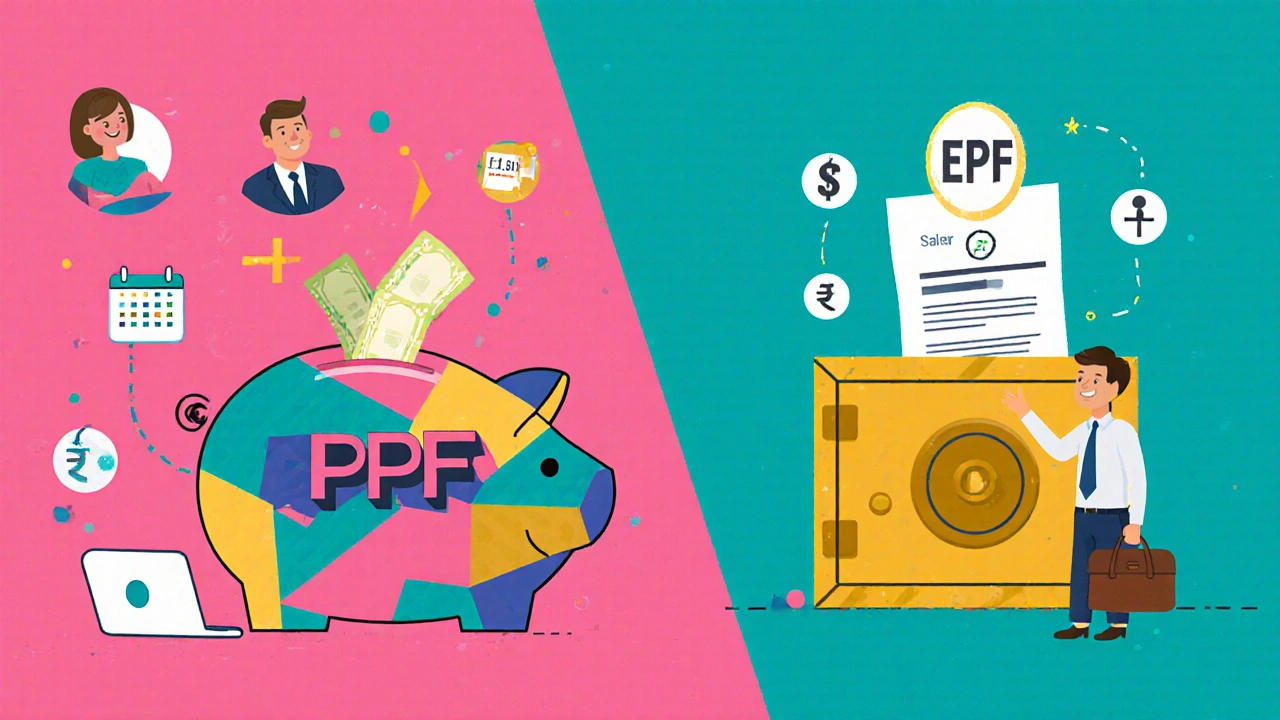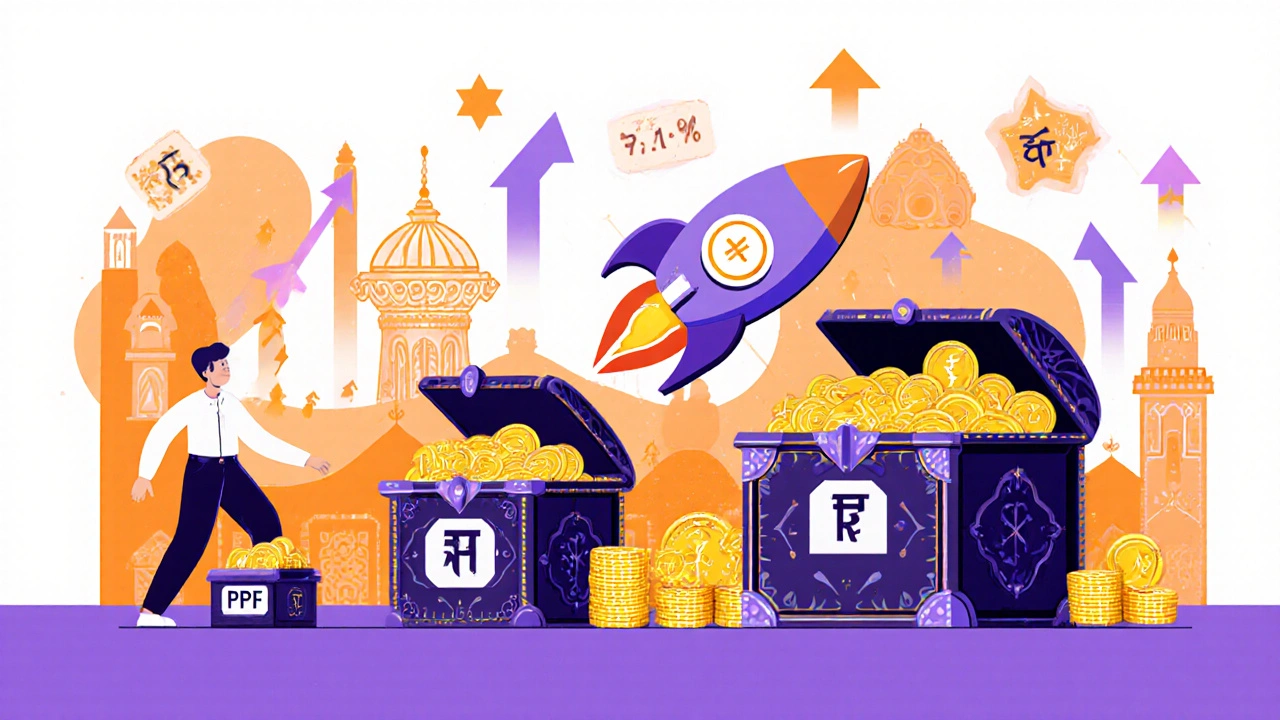PPF vs EPF for Retirement in India: Which Gives Better Returns, Safety, and Access?
 Nov, 7 2025
Nov, 7 2025
When you’re planning for retirement in India, two government-backed savings schemes keep coming up: PPF and EPF. Both promise safety and tax benefits, but they’re not the same. PPF is for anyone who wants to save on their own. EPF is for salaried employees, automatically deducted from your salary. If you’re trying to figure out which one gives you better returns, more control, or easier access to your money, you’re not alone.
What Exactly Is PPF?
PPF stands for Public Provident Fund. It’s a long-term savings scheme run by the Indian government. You open it at a bank or post office. Anyone can open a PPF account-even students, homemakers, or freelancers. You can deposit between ₹500 and ₹1.5 lakh every year. The money grows tax-free, and you get interest set by the government every quarter.
In 2025, the PPF interest rate is 7.1%. That’s been steady since early 2024. The account lasts 15 years. After that, you can extend it in blocks of five years. You can withdraw partial amounts after year 7, but only under strict limits. Full withdrawal? Only after 15 years. Early closure is allowed only in rare cases like medical emergencies.
What Exactly Is EPF?
EPF stands for Employees’ Provident Fund. It’s mandatory for employees working at companies with 20+ staff. Every month, you and your employer each contribute 12% of your basic salary plus dearness allowance. That’s 24% total going into your EPF account. The government sets the interest rate too-7.1% in 2025, same as PPF.
Unlike PPF, EPF isn’t something you choose. If you’re employed and earning under ₹15,000/month basic, you’re automatically enrolled. Even if you earn more, your employer can still enroll you. You can’t skip it. Your EPF balance moves with you when you change jobs. You can transfer it to your new employer’s EPF account.
Return Comparison: PPF vs EPF
Both PPF and EPF currently offer 7.1% interest. So on paper, they’re equal. But here’s the catch: EPF returns are higher for most people because of employer contributions.
Let’s say you earn ₹50,000/month. Your basic salary is ₹30,000. You contribute ₹3,600 (12% of ₹30,000). Your employer adds another ₹3,600. That’s ₹7,200 going into EPF every month. Over 15 years, that’s ₹12.96 lakh in contributions alone-not counting interest.
With PPF, you can only put in ₹1.25 lakh/year (₹10,416/month). Even if you max it out, you’re putting in less than half of what EPF does for a salaried worker. So even though the interest rate is the same, EPF builds a much bigger corpus because you’re getting free money from your employer.
Risk Level: Which Is Safer?
Both PPF and EPF are backed by the Government of India. That means zero risk of default. Your money won’t vanish. No market crashes. No fund manager fraud. This makes both far safer than mutual funds or stocks.
But EPF has one extra layer of protection: it’s governed by the Employees’ Provident Fund Organisation (EPFO), a statutory body under the Ministry of Labour. PPF is managed by the Ministry of Finance. Both are solid, but EPF has a more structured oversight system because it’s tied to employment.
If you’re worried about political changes affecting interest rates, don’t be. Both schemes have kept rates stable for years. Even during economic slowdowns, they’ve never dropped below 7%. That’s rare in any savings product.

Access to Your Money: Withdrawal Rules
This is where PPF and EPF split wide apart.
With PPF, you can’t touch your money for the first 5 years. After that, you can take loans or partial withdrawals. Between years 7 and 15, you can withdraw up to 50% of the balance at the end of year 4. You can only do this once per year. Full withdrawal? Only after 15 years. You can extend the account, and then you can withdraw any amount annually.
EPF is much more flexible. You can withdraw your full balance if you’re unemployed for more than two months. You can also withdraw for home loans, medical emergencies, education, or marriage. You can even take partial withdrawals after 5 years for specific needs.
Here’s a real example: A 30-year-old engineer leaves her job to start a business. She doesn’t find another job for 10 months. She can withdraw her entire EPF balance. With PPF, she’d have to wait until she’s 45 to get all her money out.
Who Should Choose PPF?
PPF is perfect if you’re:
- Self-employed or a freelancer with no employer contributions
- A homemaker or student wanting to build long-term savings
- Looking for a disciplined, forced-savings plan with no temptation to withdraw
- Wanting to invest beyond your EPF limit
Many people use PPF as a supplement to EPF. If you’re already contributing to EPF, you can still open a PPF account. It’s not mutually exclusive. In fact, combining both gives you a powerful retirement stack.
Who Should Rely on EPF?
EPF is your default retirement tool if you’re employed. You don’t need to do anything. The money gets deducted, invested, and grows. But here’s what most people miss: EPF is only as good as your salary structure.
If your employer pays you ₹15,000 basic salary, your EPF contribution is ₹3,600/month. But if you’re paid ₹50,000 basic, you still get only ₹6,000/month from your employer. That’s because the mandatory 12% applies only up to ₹15,000 basic. Above that, contributions are optional.
So if you earn more than ₹15,000 basic, ask your employer to contribute on your full salary. Some companies do. Others don’t. If they don’t, you’re leaving free money on the table.
Can You Have Both PPF and EPF?
Yes. And you should.
EPF is your core retirement engine. PPF is your safety net. If you’re employed, max out your EPF. Then open a PPF account and invest ₹1.5 lakh every year. You’ll get the same interest rate, but with more control. You can even use PPF to fund your child’s education or a down payment on a house after 7 years.
Many financial advisors in India recommend this combo: EPF for mandatory savings, PPF for voluntary growth. Together, they cover 90% of what most people need for retirement.
Tax Benefits: Both Are Exempt
Both PPF and EPF fall under EEE status: Exempt-Exempt-Exempt. That means:
- Your contributions are tax-deductible under Section 80C
- Interest earned is tax-free
- Withdrawals at maturity are tax-free
This is rare. Most investments-like fixed deposits or equity mutual funds-tax your gains. PPF and EPF don’t. Even if you’re in the highest tax bracket, your retirement corpus grows without any tax drag.
What Happens When You Change Jobs?
With EPF, you transfer your balance to your new employer’s account. It’s automatic if you link your UAN (Universal Account Number). No paperwork needed. Your money keeps growing. You don’t lose interest or tenure.
With PPF, nothing changes. Your account stays with you. You can keep contributing even if you move cities or change careers. That’s a big plus for people who switch jobs often or work in the gig economy.
Common Mistakes People Make
- Thinking EPF is enough-many stop saving after retirement because they assume EPF will cover everything. But inflation eats away at fixed returns. You need more.
- Withdrawing EPF early to pay off credit cards-this kills your long-term growth. Only do this if you have no other option.
- Not opening PPF early-PPF needs 15 years to work. If you start at 40, you won’t get the full benefit.
- Ignoring the ₹1.5 lakh limit under Section 80C-PPF and EPF both count toward this. If you invest in ELSS or life insurance, you might hit the cap and miss out on PPF benefits.
Final Decision: PPF or EPF?
Don’t pick one. Use both.
If you’re employed: EPF is your foundation. Make sure you’re contributing on the highest possible basic salary. If your employer caps it, consider asking for a raise or switching jobs.
If you want to save more: Open a PPF account. Put in ₹1.5 lakh every year. Set up auto-debit. Don’t touch it until you’re 60.
If you’re self-employed: PPF is your only government-backed retirement tool. Start now. Even ₹5,000/month adds up to over ₹1 crore in 30 years at 7.1% interest.
Both schemes are designed to protect your future. They’re not investment tools for quick gains. They’re long-term, low-risk, tax-free vaults for your retirement. The best strategy? Start early. Contribute consistently. Don’t touch the money. Let compounding do its job.
Can I withdraw my EPF money before retirement?
Yes, but only under specific conditions. You can withdraw your full EPF balance if you’re unemployed for over two months. You can also withdraw partial amounts for home loans, medical emergencies, education, or marriage after five years of service. Early withdrawals reduce your retirement corpus, so use them only in true emergencies.
Is PPF interest rate fixed for life?
No. The interest rate for PPF is revised every quarter by the Ministry of Finance. It’s based on the 10-year government bond yield. But historically, it’s stayed between 7% and 8% for over a decade. Even if it drops to 6.5%, your money remains safe and tax-free.
Can I open a PPF account for my child?
Yes. Parents can open a PPF account for their minor child. The total contribution limit across both your account and your child’s account is ₹1.5 lakh per year. You can’t open a PPF account for your spouse. Only one account per person, including minors.
What happens to my EPF if I move abroad?
If you move abroad permanently and don’t get a job in another country, you can withdraw your entire EPF balance after two months of unemployment. You’ll need to submit Form 19 and proof of overseas relocation. If you get a job abroad, you can leave your EPF untouched-it keeps earning interest until you return or withdraw.
Is EPF better than PPF for retirement?
It depends. EPF gives you higher contributions because your employer matches your pay. But PPF gives you more control and flexibility. If you’re employed, EPF is your main tool. If you want to save more or are self-employed, PPF fills the gap. Together, they’re the strongest retirement combo in India.
